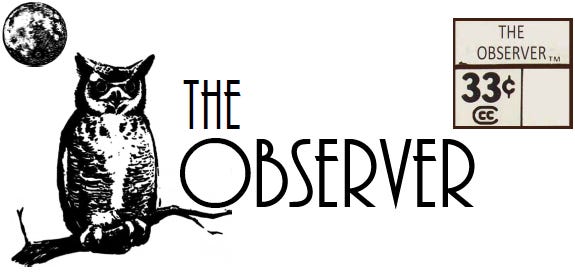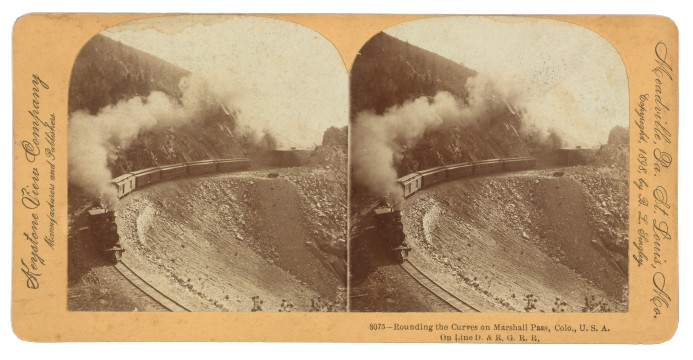Echoes on the Rails, Part 1
All aboard! We ride the rails with a "phantom train" expert in an attempt to understand this persistent phenomenon.
The faces laughing at engineer Edwards through the window of his narrow-gauge train were disturbing and unnatural. “Tall white figures” with features “like dough” occupied the cab of the rival locomotive that had suddenly materialized on the track behind him. Moving with supernatural speed, it threatened to overtake his rig in short order. It was a snowy night in Marshall Pass, and as Edwards creaked his way through the Colorado Rockies, his mind raced with the possibilities. Officially, the spook train didn’t exist—yet the conductor clearly heard its warning whistle and his terrified passengers caught sight of it pacing their car. As the white knuckled sprint continued through the mountains, it dawned on Edwards that he was running from a ghost. His pursuer was none other than the legendary phantom train that haunted this very stretch of track.
The spectral locomotive failed to catch him. Instead, it came loose from the rails in an eerie replay of the vehicle’s original fatal accident. The doughy entities managed to send a message through the void before disappearing—advising Edwards to avoid the passage next time, unless he wished to share their fate. The seasoned engineer decided that he didn’t, and he quit the route the next day.1
Inexplicable “phantom” trains like the one encountered in Marshall Pass have been spotted regularly in the United States ever since railroads began carving up the landscape in the mid- 1800s. As transcontinental networks multiplied in the latter part of the century, so did reports of luminous locomotives.
Far from being a one-dimensional phenomenon, spook trains display a wide range of characteristics. While some appearances seem random, others follow strict rules and reliable timetables. Some phantom trains are boisterous. Others pass in silence. There are ones that bring good tidings, and others that signal bad luck. With all of this variability, what conclusions can we draw? Does it reveal anything about the phenomenon, or is it all just a smoke screen for the truth?
To get to the bottom of this mystery, we enlisted the help of an authority: Tim Prasil, author and owner of Brom Bones Books.
Professor Prasil has forgotten more about haunted locomotives and railways than we’ll ever learn—and his anthology, After the End of the Line: Railroad Hauntings in Literature and Lore, is a must-read for anyone interested in the topic. Before we consult our expert, it’s important to provide some additional context about the various types of phantom trains reported over the years.
Bearers of Bad News
Some reports suggest that ghostly locomotives act as forerunners to disaster. This was the case in Maine where an unseen phantom engine served as a premonition. A man who heard the invisible machine roar by him on an abandoned span of track later learned that his wife and child had died in a train accident that same day.2
A similarly grave case comes from the mountains of Tennessee, where the sight of a ghost train spelled death for one of the crew. The fireman was the first to spot the glowing locomotive hovering in the heavens above the eastern peaks. Onlookers claimed it was spewing smoke and pulling a line of cars with illuminated windows. When the hysterical crewman notified his captain about the aerial anomaly, the captain saw it as well. (Curiously, this incident featured hallmarks of “missing time”—a phenomenon often reported by UFO abductees. The engineer couldn’t recall how long he watched the train in the sky before it fizzled out, but when the ringing of the conductor’s bell finally brought him back to reality, he was surprised to learn that 30 minutes had disappeared.)
Unfortunately, the sighting proved unlucky for the first witness. Two days after the sighting, the ill-fated fireman was crushed into “jelly” by a runaway train in the same location, at the same time of day.3
Other phantom train prophecies were less distressing. In 1883 a Michigan family collectively witnessed a dream-like train passing by their home in a place where no tracks existed. Three years later, a new railroad was built exactly where their vision suggested.4
Whispers on the Tracks
Not every ghost train is a noisy affair. Some models are seen but not heard.
For years the city of Dalton, Georgia hosted a noiseless machine driven by “spectre like” crewmen.5 One observer saw the apparitions inside frantically ringing the train’s bell, yet no sound broke the stillness of the night. Another witness vouched for the muted nature of the locomotive, adding that as it cruised past him, “it was as though a mist or a fog had suddenly passed his vision.”6
Out on the Pacific Coast, a crew of night haulers caught sight of a silent, “diaphanous” train chasing them on a parallel set of tracks. As it pulled up alongside their rig, the men strained to catch a glimpse of the driver. To their horror, the other cab was empty. It was also still inaudible—a combination that terrified the flesh-and-blood men aboard the iron-and-steel train. The mortal engineer decided to abandon the unwinnable race and threw on his air brakes. It was the right call. They narrowly missed colliding with a wrecked car full of dazed passengers.7 Was the spook train sent to warn of the trouble ahead?
Heard and Not Seen
In 1856, folks in Plymouth, MA were plagued by a consistent commotion on the tracks between the unholy hours of 3:00-4:00 AM (the traditional Witching Hour). The “invisible spectre” emitted all of the appropriate train sounds—belching steam, screaming whistle, grinding brakes—but bystanders were left with only auditory impressions of its arrival. One witness later visited a spirit medium who channeled the non-human engineer. He insinuated that the vehicle was transportation for the afterlife, but in typical disembodied-entity fashion, he clammed up when pressed for specifics: “It’s not for mortals to know more.”8
That same year, a phantom train manifested to a crowd of hundreds in the sleepy Appalachian town of Staunton, VA. Residents were rudely awakened on five successive nights by a loud locomotive pulling into the town’s depot. Confused officials swore that no vehicles were in the area despite the repeated disturbance. The local paper considered the whole thing “very strange” and in short order, the villagers gathered a posse to greet their mysterious midnight visitor. All assembled heard the familiar sounds of an engine easing into the station, but nothing visible accompanied the ruckus.9
Silent spirit exhibitions. Anomalous sounds without a source. These paranormal phenomena aren’t new. Welsh folklore tells of an ominous noise heard before great disasters, known as the Tolaeth. The Tolaeth usually simulates some earthly sound—like the construction of a coffin or the ringing of a bell. Yet, like our phantom train, it can flip the script and “make itself known to the eye also—but in silence.”10 Are these variations of a shared cultural experience? Or do these similar legends suggest that something odd has been with us for a long time—manifesting in different forms—but adhering to the same basic rules?

It’s Always Spooky in PA
Phantom trains had a penchant for Pennsylvania’s railways. One was frequently reported near Factoryville running on a “haunted stretch of track” near the 3,600-foot tunnel that connected it to the neighboring town of Nicholson. Sometimes the train pulled cars of wailing passengers. Other times it was invisible. Once, it was sighted just before a devastating derailment. Afterward, it remained in the area giving encore performances of the awful accident. The experience was so realistic that hotel guests ran to the station under the assumption that their evening express had arrived early.11
Another phantom flyer made its presence known on the 30-mile segment joining the cities of Carrolltown and Johnstown. Dozens of astonished witnesses saw the mystery train near a newly built tunnel before it vanished with a bang. Per usual, some of the more paranoid citizens suggested its presence was a warning of danger.12
Another silent specter was sighted in Hanover, PA, where it crossed the same span of track each night and stuck to a strict 1:00 AM arrival.13
The “Exeter Horror,” a chilling incident involving two trains and 29 casualties, seemingly gave rise to a pair of luminous locomotives. Observers saw two soundless engines collide and then evaporate without leaving behind a shred of evidence.14
Other reports indicate that spook trains weren’t the only supernatural freight hoppers in The Quaker State—the Devil was also making his presence known. One engineer saw the fiery-eyed demon perched atop his rig’s cow catcher.15
Punctual Phantoms
As the previous examples suggest, spook trains often adhere to tight schedules. The phantom of Newark, New Jersey was painstakingly precise—arriving like clockwork at midnight on the 10th of each month. Eager to unravel the mystery, hundreds of brave Newarkians gathered on the 10th of February at the Broad Street Depot, enduring freezing temperatures just to catch a glimpse of their timely, out-of-time visitor. It never arrived. They were ghosted by the ghost train. The only indication of its presence—a haunting steam whistle that startled the crowd—was chalked up to a playful railroad employee.16
Macon, Mississippi featured its own dependable spirit conductor who slid into the local station promptly at the stroke of 12:00 AM. Undoubtedly the city’s most reputable citizen—its mayor—witnessed the engine towing a line of “misty looking cars” with skeletons in the windows.17
A famous ghost locomotive paraded along the New York Central line in April every year—the same month that President Abraham Lincoln was assassinated. A station watchman revealed that the sightings coincided with other high strangeness events: temperatures fluctuated, the air took on a peculiar quality, and clocks in the vicinity stopped working for about 5-8 minutes.18 (This type of time distortion is commonly reported alongside alien abductions, cryptid encounters, and ancient fairy lore.)
Now that we’ve sufficiently ridden the rails into spook territory, it’s time to seek answers about these enigmatic engines. That’s where the generous and knowledgeable Tim Prasil comes in. Prasil boasts a library of work about paranormal topics and historical ghostlore—and he was patient enough to entertain our questions about phantom trains.
So grab your bindle and hop aboard! Next stop: the publishing “cottage” of Brom Bones Books (Part 2, coming very soon).


“The Phantom Train.” Arkansaw Traveler, 13 July 1889, p. 6.
“The Phantom Train.” Alexandria Gazette, 20 May 1886, p. 2.
“Railroad Stories.” The Seattle Post-Intelligencer, 21 November 1888, p. 6.
Mineral Point Tribune, 14 October 1886, p. 4.
Savannah Morning News, 22 January 1881, p. 1.
“A Phantom Locomotive.” North Georgia Citizen, 6 September 1883, p. 3.
Cagy, F. Jay. “Will the Phantom Locomotive Visit Visitacion?” The San Francisco Call, 10 May 1908, p. 4.
“Spirits Running Locomotives.” Daily American Organ, 4 January 1856, p. 2.
“Mysterious Locomotive.” Staunton Spectator, 8 October 1856, p. 1.
Sikes, Wirt. British Goblins: Welsh Folklore, Fairy Mythology, Legends and Traditions. 1880, p. 236.
“A Phantom Train.” The Cambria Freeman, 1 Aug. 1873, p. 2.
“The Say They Saw a Phantom Train.” Freeland Tribune, 31 Oct. 1892, p. 4.
“A Phantom Train.” Martinsburg Independent, 19 Dec. 1885, p. 3.
“Berks County Spooks.” Shoshone Journal, 21 Aug. 1899, p. 2.
“A Phantom Train.” The Jeffersonian, 7 March 1872, p. 3.
“Six Hundred People Gathered at Midnight to Behold the Spectral Locomotive.” Portland Daily Press, 19 Feb. 1873, p. 1.
The Dallas Daily Herald, 27 October 1874, p. 1.
“A Superstitious Night Watchman.” The Daily State Register, 27 Nov. 1872, p. 1.










I once saw a ghost at a rarely used railroad crossing in the middle of a SoCal orange grove. No train, just the ghost.
"Next stop is Willoughby..."